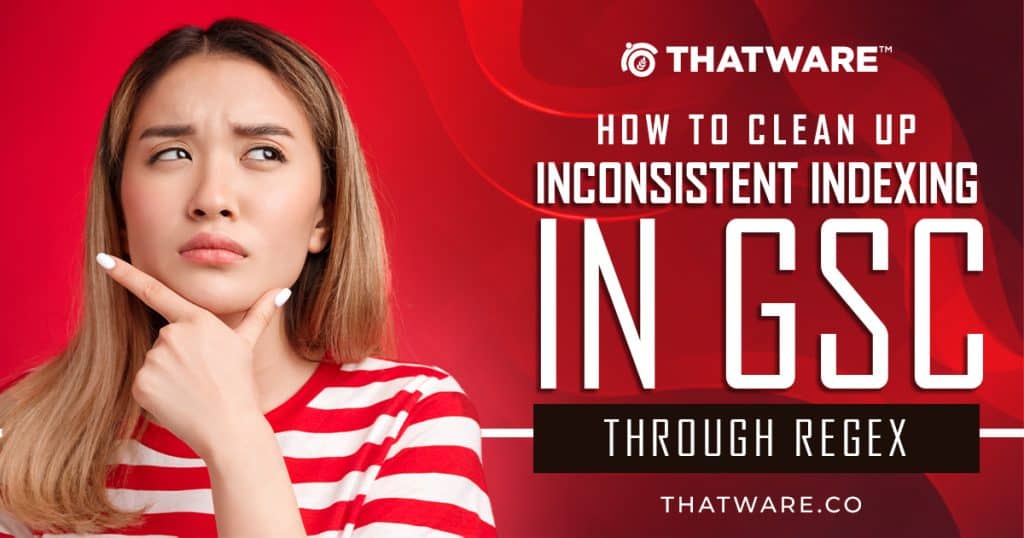SUPERCHARGE YOUR ONLINE VISIBILITY! CONTACT US AND LET’S ACHIEVE EXCELLENCE TOGETHER!
As we stepped into the new year, it is imperative to take all the necessary technical SEO stuff well-aligned with our SEO campaigns. It is high time to find out any existing inconsistencies in the current SEO journey. Thus, in this context, we are going to unleash the steps to clear up any inconsistent indexing with trailing / non-trailing slash.

In order to perform the steps, do the following.
Step 1:
Go to Google Search Console
Step 2:
Open your URL/Domain property, go to performance and select the last 16 months, as shown below:
Step 3:
Select PAGE FILTER and use MATCHES REGEX and put in .*\/$ – then export the URLS
Here’s the output:
Step 4:
Then change to DOESN’T MATCH REGEX and leave .*\/$
in place and export (if URLs exist)
Here’s the output:
If you find loads of auxiliary / JUMP Links you can amend the regex to
.*\/$.*\#$
Action to be taken:
Once you are done with exporting URLs from both – you should then HTTP check the non-default protocol.
Make sure to double-check before removing any URLs from the live website, if it is irrelevant to your campaign only then you should remove it or else keep it as it is.
Sidenote:
1. Always force a trailing slash / non-trailing slash and make it consistent
2. Do not rely on canonicals
3. Make sure your internal linking sitewide is consistent – crawl your website with Screaming Frog SEO spider and use the INLINKS option on any URLs where there is inconsistency as shown below:
4. If you switched from trailing to non-trailing or vice versa – run an AHREFS BATCH ANALYSIS on the OLD URL paths to see which have external links (in case you do not have a redirection in place).
Understanding the Importance of Consistent Indexing
In the ever-evolving landscape of search engine optimization (SEO), maintaining consistent indexing is crucial for ensuring the visibility and accessibility of your website’s content to both users and search engines. Inconsistent indexing, particularly with regard to trailing slashes in URLs, can lead to issues such as duplicate content, crawling inefficiencies, and diminished user experience. Addressing these inconsistencies proactively can help improve the overall health and performance of your website in organic search results.
Identifying Inconsistent Indexing in Google Search Console
Google Search Console serves as a vital tool for monitoring and managing the indexing status of your website’s pages. By analyzing performance data and utilizing filters such as regex, webmasters can pinpoint instances of inconsistent indexing, particularly related to URLs with trailing slashes. The use of regex enables precise pattern matching, allowing webmasters to identify URLs that deviate from the desired indexing format.
Performing Regex-Based Analysis in Google Search Console
To address inconsistent indexing effectively, webmasters can follow a systematic approach using regex within Google Search Console. By applying regex filters to performance data and exporting relevant URLs, webmasters can isolate instances of inconsistent indexing and take appropriate action to rectify them. This process involves iteratively refining regex patterns and scrutinizing exported URL lists to identify and categorize problematic URLs for further analysis.
Analyzing Exported URL Data
Once URL data has been exported from Google Search Console, webmasters can conduct a comprehensive analysis to identify patterns and trends related to inconsistent indexing. This analysis may involve examining URL structures, identifying commonalities among problematic URLs, and assessing the impact of inconsistent indexing on user experience and search engine visibility. By gaining insights from exported URL data, webmasters can develop strategies for resolving indexing inconsistencies effectively.
Taking Action to Resolve Inconsistent Indexing
After identifying URLs with inconsistent indexing, webmasters can take proactive measures to address these issues and improve overall indexing consistency. This may involve implementing redirects, canonical tags, or other technical solutions to standardize URL formats and eliminate duplicate content issues. Additionally, webmasters should ensure that internal linking structures are optimized to facilitate efficient crawling and indexing by search engines.
Monitoring and Maintenance
Once corrective actions have been implemented, it is essential to monitor the impact on indexing consistency and overall website performance. Regularly reviewing indexing data in Google Search Console, monitoring crawl activity, and tracking changes in search engine rankings can help ensure that indexing issues are effectively resolved and that the website maintains optimal visibility in organic search results. Ongoing maintenance and proactive management of technical SEO issues are critical for sustaining long-term success in organic search.
Advanced Techniques for Identifying and Resolving Inconsistent Indexing
While the steps outlined for using regex in Google Search Console provide a solid foundation for addressing inconsistent indexing, there are advanced techniques and tools available for more comprehensive analysis and resolution. These techniques may include:
Custom Regex Patterns: Beyond the basic regex pattern provided, webmasters can develop custom regex patterns tailored to their specific indexing issues. This customization allows for more precise identification of problematic URLs and enhances the efficiency of the cleanup process.
Data Visualization: Utilizing data visualization tools such as Google Data Studio or Tableau can provide insights into indexing trends and anomalies. By visualizing indexed versus non-indexed URLs over time, webmasters can identify patterns and prioritize areas for improvement.
Log File Analysis: Analyzing server log files can uncover indexing issues that may not be apparent in Google Search Console. Log file analysis reveals how search engine bots crawl and index the website, allowing webmasters to identify crawling inefficiencies and prioritize URL cleanup efforts accordingly.
Machine Learning Algorithms: Leveraging machine learning algorithms for anomaly detection can enhance the efficiency of identifying inconsistent indexing patterns. By training algorithms on historical indexing data, webmasters can automate the detection of anomalies and streamline the cleanup process.
Case Studies and Success Stories
To illustrate the effectiveness of addressing inconsistent indexing through regex and other advanced techniques, let’s explore real-world case studies and success stories from businesses and organizations that have implemented these strategies:
E-commerce Website Optimization: A large e-commerce retailer identified inconsistent indexing issues across product category pages due to variations in URL structure. By implementing custom regex patterns and 301 redirects, the retailer standardized URL formats and improved indexing consistency, resulting in higher search engine rankings and increased organic traffic.
Publishing Platform Overhaul: A popular publishing platform struggled with duplicate content issues stemming from inconsistent indexing of article URLs. Through comprehensive log file analysis and machine learning algorithms, the platform identified and resolved indexing inconsistencies, resulting in improved user experience and higher engagement metrics.
Local Business SEO Enhancement: A local business noticed discrepancies in indexing for location-specific landing pages, leading to decreased visibility in local search results. By leveraging regex filters in Google Search Console and optimizing internal linking structures, the business achieved greater consistency in indexing and saw a significant increase in local search rankings and foot traffic.
Best Practices for Long-Term Indexing Consistency
In addition to addressing immediate indexing issues, implementing best practices for long-term indexing consistency is essential for maintaining website health and performance. These best practices include:
Regular Monitoring and Maintenance: Continuous monitoring of indexing status in the Google Search Console is essential for maintaining the health and performance of a website in organic search results. By regularly reviewing indexing data and conducting periodic audits, webmasters can identify and address emerging inconsistencies promptly. This proactive approach allows for the timely detection and resolution of indexing issues such as duplicate content, crawling inefficiencies, and URL formatting discrepancies. By staying vigilant and proactive in monitoring indexing status, webmasters can ensure that their website remains visible and accessible to both users and search engines, ultimately maximizing organic search traffic and driving meaningful results.
Canonicalization: Canonical tags play a pivotal role in mitigating duplicate content issues and enhancing indexing consistency by signaling to search engines the preferred version of a webpage when multiple variations exist. While it’s crucial not to solely depend on canonical tags for addressing indexing inconsistencies, implementing canonicalization correctly can effectively consolidate duplicate content and streamline the indexing process. By specifying the canonical URL for duplicate or similar pages, webmasters can ensure that search engines prioritize indexing and ranking the preferred version, thereby avoiding dilution of search equity and improving overall website performance in organic search results.
URL Structure Standardization: Establishing clear guidelines for URL structure is essential to ensure consistency across a website, which aids in both user experience and search engine optimization. This involves defining a logical hierarchy for organizing URLs, including consistent use of categories, subcategories, and descriptive slugs. Implementing redirects, such as 301 redirects for permanent URL changes or canonical tags for duplicate content, helps enforce standardized URL formats and prevents indexing of redundant or outdated URLs. Additionally, employing URL rewriting rules, either through server configurations or content management systems, ensures that URLs are consistently formatted according to predetermined guidelines, enhancing the website’s navigability and search engine visibility.
Robots.txt Optimization: Optimizing the robots.txt file is crucial for controlling crawling and indexing behavior to prevent search engines from accessing and indexing irrelevant or sensitive content on a website. By strategically configuring the robots.txt directives, webmasters can specify which parts of the site should be crawled and indexed by search engine bots and which parts should be excluded. This allows for fine-grained control over the dissemination of content, ensuring that confidential information, duplicate content, or non-essential pages are not indexed, thereby preserving the crawl budget and optimizing the visibility of relevant, high-quality content in search engine results pages (SERPs). Properly optimizing the robots.txt file helps maintain the integrity of the website’s information architecture while enhancing security and compliance with privacy regulations.
Conclusion
In conclusion, addressing inconsistent indexing in Google Search Console through the use of regex and proactive technical SEO strategies is essential for maintaining website health and optimizing search engine visibility. By systematically analyzing performance data, identifying patterns of inconsistent indexing, and implementing targeted solutions, webmasters can enhance the consistency and accuracy of their website’s indexing, ultimately improving user experience and driving organic traffic. By prioritizing indexing consistency and adopting a proactive approach to technical SEO, webmasters can position their websites for long-term success in organic search.

Thatware | Founder & CEO
Tuhin is recognized across the globe for his vision to revolutionize digital transformation industry with the help of cutting-edge technology. He won bronze for India at the Stevie Awards USA as well as winning the India Business Awards, India Technology Award, Top 100 influential tech leaders from Analytics Insights, Clutch Global Front runner in digital marketing, founder of the fastest growing company in Asia by The CEO Magazine and is a TEDx speaker and BrightonSEO speaker.


